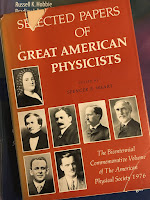 |
| Iron, Nature's Universal Element: Why People Need Iron and Animals Make Magnets, by Eugenie Mielczarek. |
Magnetism is used for orientation by several organisms. A history of studies in this area is provided in a very readable book by Mielczarek and McGrayne (2000).My favorite part of Iron, Nature’s Universal Element was Chapter 4, on magnetotactic bacteria. Russ and I discussed these interesting little creatures in Section 8.8.3
Several species of bacteria contain linear strings of up to 20 particles of magnetite, each about 50 nm on a side encased in a mambrane [Frankel et al. (1979); Moskowitz (1995)]. Over a dozen different bacteria have been indentified that synthesize these intracellular, membrane-bound particles or magnetosomes (Fig. 8.25). Bacteria in the northern hemisphere have been shown to seek the north pole. Because of the tilt of the earth’s field, they burrow deeper into the environment in which they live. Similar bacteria in the southern hemisphere burrow down by seeking the south pole. In the laboratory the bacteria align themselves with the local field.The caption to our Figure 8.25 reads
The small black dots are magnetosomes, small particles of magnetite in the magnetotactic bacterium Aquaspirillum magnetotacticum. The vertical bar is 1 [micron] long. The photograph was taken by Y. Gorby and was supplied by N. Blakemore and R. Blakemore, University of New Hampshire.Mielczarek and McGrayne provide a colorful description of how magnetotactic bacteria were discovered.
“I see it crystal clearly,” Richard Blakemore said, recalling the evening he discovered Earth’s smallest living magnets. “I get excited every time I look at them.”
It was already dark outside the laboratory as Blakemore, peering through his microscope, searched through mud samples for bacteria. At twenty-three, Blakemore was a second-year graduate student in microbiology at the University of Massachusetts in Amherst. In 1975, fledgling microbiologists there were often assigned such simple tasks as identifying the material between their teeth or analyzing organisms in mud. His professor had collected the mud from a Massachusetts marsh, and asked Blakemore to learn everything possible about some large spiral bacteria in it. But that night, Blakemore said, “other organisms forced their existence on me...”
So while Blakemore looked through the scope, [advanced graduate student John Bresnick] picked up a magnetic stirrer lying beside the microscope and brought it up behind the swimmers. “Fortunately,” Blakemore recalled, “he had the end of the magnet pointing toward them so that it attracted them. And—all of a sudden—en masse—this whole massive population of bacteria swims in exactly the opposite way across the microscope stage. It was incredible, just incredible, and no one even believed my response. They thought I was kidding—until they looked in...” At that point, John Bresnick said, “I think you’ve discovered something...” “From then on,” Blakemore said, still starry-eyed more than twenty years later, “it was a night of incredulity...”
Blakemore’s microbiology professor was in Italy at the time, and Blakemore was exploding with the news, so he raced home to tell his wife Nancy. Abandoning all grammar in the joy of the memory, Blakemore said “It couldn’t have been perfecter. I didn’t really—hardly—know how to take it in.”







